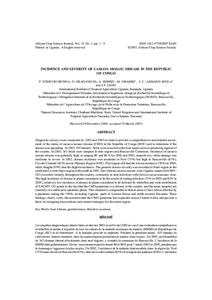| dc.contributor.author | Ntawuruhunga, Pheneas |
| dc.contributor.author | Okao-Okuja, G. |
| dc.contributor.author | Bembe, A. |
| dc.contributor.author | Obambi, M. |
| dc.contributor.author | Armand Mvila, J.C. |
| dc.contributor.author | Legg, J.P. |
| dc.date.accessioned | 2019-12-04T11:14:12Z |
| dc.date.available | 2019-12-04T11:14:12Z |
| dc.date.issued | 2007 |
| dc.identifier.citation | Ntawuruhunga, P., Okao-Okuja, G., Bembe, A., Obambi, M., Armand Mvila, J.C. & Legg, J.P. (2007). Incidence and severity of cassava mosaic disease in the Republic of Congo. African Crop Science Journal, 15(1), 1-9. |
| dc.identifier.issn | 2072-6589 |
| dc.identifier.uri | https://hdl.handle.net/20.500.12478/2688 |
| dc.description.abstract | Diagnostic surveys were conducted in 2002 and 2003 in order to provide a comprehensive and detailed assessment of the status of cassava mosaic disease (CMD) in the Republic of Congo (ROC) and to determine if the disease was spreading. In 2002, 105 farmers’ fields were assessed in the four major cassava-producing regions of
the country. In 2003, 163 fields were sampled in nine regions and Brazzaville Commune. Incidence of cassava mosaic disease was generally high, averaging 80 and 86 % for 2002 and 2003, respectively; while damage was moderate to severe. In 2002, disease incidence was moderate in Pool (73%) but high in Brazzaville (81%),
Cuvette Centrale (82%) and in Plateaux Region (84%). Pool region still had the lowest incidence (78%) in 2003, while Sangha (95%) had the highest incidence. The greatest disease severity was recorded in Niari region in the south and Cuvette Ouest region in the north in 2003. East African cassava mosaic virus Uganda variant (EACMVUG) occurred virtually throughout the country, commonly in dual infections with African cassava mosaic virus. The high incidence of disease in plants considered to be the results of cutting infection (74% in 2002 and 82% in 2003), relatively low incidence of disease in plants considered to be infected by whiteflies and wide distribution of EACMV-UG points to the fact that the CMD pandemic is a chronic in the country and the areas sampled are currently in a stable post-epidemic phase. This situation is comparable to that in areas of East Africa affected by a pandemic during the 1990s, including Uganda, parts of western Kenya and north-western Tanzania. These findings clearly verify the assertion that the CMD pendemic has expanded across Central Africa and provide a
basis for designing interventions and control strategies for the entire region. |
| dc.description.sponsorship | Office for United States Foreign Disaster Assistance |
| dc.format.extent | 1-9 |
| dc.language.iso | en |
| dc.subject | Cassava |
| dc.subject | Manihot Esculenta |
| dc.subject | Geminiviruses |
| dc.subject | African Cassava Mosaic Virus |
| dc.title | Incidence and severity of cassava mosaic disease in the Republic of Congo |
| dc.type | Journal Article |
| dc.description.version | Peer Review |
| cg.contributor.affiliation | International Institute of Tropical Agriculture |
| cg.contributor.affiliation | Ministère de l'Enseignement Primaire, Secondaire et Supérieur, chargé de Recherche Scientifique et Technologique, République du Congo |
| cg.contributor.affiliation | Ministère de l'Agriculture de l'Elevage, de la Pêche et de la Promotion Feminine, République du Congo |
| cg.coverage.region | Africa |
| cg.coverage.region | Central Africa |
| cg.coverage.region | East Africa |
| cg.coverage.country | Congo |
| cg.coverage.country | Kenya |
| cg.coverage.country | Tanzania |
| cg.coverage.country | Uganda |
| cg.creator.identifier | Pheneas Ntawuruhunga: 0000-0003-2330-9070 |
| cg.creator.identifier | James Legg: 0000-0003-4140-3757 |
| cg.authorship.types | CGIAR and developing country institute |
| cg.iitasubject | Cassava |
| cg.iitasubject | Plant Diseases |
| cg.iitasubject | Plant Production |
| cg.journal | African Crop Science Journal |
| cg.howpublished | Formally Published |
| cg.accessibilitystatus | Limited Access |
| local.dspaceid | 93609 |
| cg.targetaudience | Scientists |

